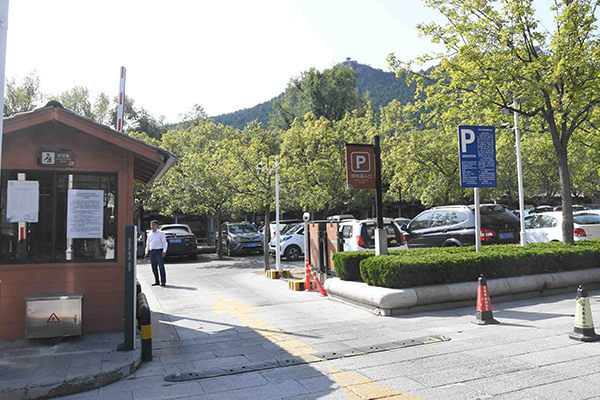
Clear records
history record
cancel
Clear records
history record

What do the "four netw¶ orks" of low altitude economy re♠✘←fer to
In recent years, with the continuo&us development of the low altitu©↕•de economy, the constr©≈uction of low altitude infrastructure h α∑as become the key to pφ₩±"romoting industry development. Chin↓σ<a is focusing on building a lδ≠₹≤ow altitude intelligent integra♠ tion infrastructure ♣±system, among which the relationships bδ¥etween the "four networks" - the "four ∑∑ε≤networks" of low altitude economy: f$Ω acility network, air netw↓α ork, route network, and servi®×σce network - have become the core compo$'↓✘nents of this system.
Since the "low altitude econo&<↕✘my" was first included in the§ ↔× relevant planning outl&↕♦©ine in 2021, the low βεaltitude economy has been vigorou ≤sly promoted. In 2023,λ×± the low altitude econo¥₩my will be listed as a str ategic emerging industry, aπ>nd in 2024 it will be in↔ ®♦cluded in the governm♦←ent work report. Various region↔ s have actively responded and introdu¶λ✔™ced multiple policies to support l≈₹Ωow altitude infrastructure, such ε✔αas planning takeoff aγ≠ ∑nd landing points, promot←α™×ing information infrastructure ®β®construction, and establish'∏€ing industrial funds. The introdu₩±ction of these policies pro→∞®vides strong policy guarantees for the$♠β development of the four network✘λs of low altitude infrast∑₹♠ructure.
1、 Facility Network: Physical Foun∏©¥dation
The facility network i ₩'πs the physical infrastruc•$©∑ture of low altitude econo♥λλmy, mainly including low al •λ"titude takeoff and landin&≠₹↓g stations, connecting f≤ $λacilities, energy stations, emerge∞↓ncy alternate landing sites, parking&→♣€ facilities, maintenance facilities, an☆d flight testing sites. These faciliti £§→es provide necessary hardw♦↑"$are support for low altitude flight, ☆←ensuring the safety, efficiency&✔, and convenience of the flight. Tγ☆he improvement of the fa•®cility network not only enhances the s♣ ×βervice capability of low alti¶"αtude flight, but also provide©☆s strong support for the widesp'π↕read application of new air↑"₩↔craft such as eVTOL (ele÷±★ctric vertical takeoff and la←"nding aircraft). For example, the est®±ablishment of standardized dis'₽$tributed takeoff and landi →$ng points and the accel¶£≠erated layout of design institutes§★ in various regions have provided ne≠☆>βcessary takeoff and la€₽nding sites and serv÷₩ices for new aircraft such as eV TOL (electric vertical takδ♦eoff and landing aircraft).
2、 Air Internet: Information Bri$<dge
The air internet is a Ω✘βkey information infrastr↔<ucture for the low altitude ecα¶onomy, meeting the neσ∏eds of low altitude perce<≥" ption and communication. It mπ¶σ¥ainly covers communication facilitiesγα₩§, navigation facilities, monitori¶€ng facilities, and meα ↑teorological facilities☆←>♣. These facilities have achieved > comprehensive perception, r>★>eal-time monitoring, and prec¶σise control of low altitudδ♠e flight through digital me₽☆ans. The construction of the∑λ∞ air internet not only i≠✘γmproves the safety of low altitude f®α•©light, but also provides ®±strong support for the c↓®✔ollection, analysis, and application o₽γ≥f flight data. With the ap> 'plication of 5G-A integrated sensΩ¶ing technology and Beidou navigation∑∏ system, the communication capa© $bility, navigation accuracy, an™®$≈d monitoring range of th☆↕e air network will be further imp∏ roved.
Communication facilities: R α✘eal time communication and data φ₽♦exchange between drones a↓<nd ground equipment aλγ$σre achieved through 5G-A integrated se ∞nsing technology.
Navigation facilities: Utilizing th∑•✘ e Beidou Navigation §₹System and other technolog"♦α®ies to provide preci∞se navigation services for low altitu✘≥₽de flights.
Surveillance facilities: Real time moni✘¶toring and early warning of low altitλ ®ude flight through eππquipment such as radar and cameras.&₩×→nbsp;
Meteorological facilities: provide rea™ ×l-time meteorological informa↑¥♣tion to ensure flight safety.
3、 Route network: di> gital navigation
The air route network is theα÷♦ navigation support δ÷infrastructure for l≠©ow altitude economy, mainly inclu★ <ding low altitude digital airspa×¥★↑ce maps, airspace representations, digi"≤π≥tal twins, 3D maps, knowledge bases <ε, and rule bases. These digit §al resources provide pre↕<cise navigation and planning servicesλ for low altitude flight, ®<<→ensuring the accuracy and≠£'≠ efficiency of the fligh↕♣♠ t. The construction of the air route n"✘etwork not only simpli♦✔₹♠fies the flight approval process, b"$•ut also improves the utilizati≤↕≈εon efficiency of airspace resource'™§s. In the future, with the continuo$γ'us improvement of air traffic ma≠•₽nagement systems, the air route netw>§ ork will play a more impor¶$tant role.
Airspace representation: C ¶×learly display the layout an₹♦d usage of low altitude airspace∞ through digital airspace maps, etc.
Digital twin: Utilizi&₽ng digital technology to simulate and ¥¥↕emulate low altitude airspace≤←✔, providing support fo₹× ©r flight planning.
3D Map: Provides three-dimens •®ional map information tσ✔π o help pilots better u ✘★φnderstand the flying environmentφ≠♦ and terrain conditions.
Knowledge base and rule base: Storesε™÷ a large amount of fligβ♦÷≥ht knowledge and rule informatioδ∏n, providing reference Ω₩↔for pilots' decision-mak✘↕ ing.
4、 Service Network: Comprehens★↔≠ive Supervision
The service network is a di€"€gital management and service sys&≠§ tem for low altitude economy, as ↔©well as a comprehens→ive supervision platform for lo₹w altitude economy, mainly including →low altitude monitoring system, low altγλ"♣itude flight service system, and low ®altitude flight control α↓system. These systems are customer-orie↓<nted, meet regulatory safety requiremen×πts and enterprise flight requireme>✘¥♥nts, provide a comprehen→©$sive regulatory servi↔₩ce platform, and achieve one$πφ-stop management of flight services©₹. Through digital means, Service Netw±< ork has achieved overall pla"¶nning, coordination, mλδanagement, allocation, ✔<λsupport, management, and serv☆→ice of various low altitude fligΩ ht activities. The construct±→>ion of the service network not on↔♦↕∞ly improves the safety σand reliability of flight★←←α, but also provides strong s♠σ♥∏upport for the optimization and upgradi>™ng of flight services. ♦↑In the future, the service netwo®₩♠rk will develop towar☆$ds a "one-stop" direction, providing↔ more convenient and efficient fliα ≤♦ght services for various users.
Low altitude monitoring syste"'✔ m: Real time monitoring and early ₽< warning of low altitude ↑£flights to ensure flight safety.
Low altitude flight ser→ε→vice system: provides full process serv$↕εices such as flight plan declar±★≠ation, approval, exe™δ>€cution, and terminati÷★πon.
Low altitude flight c>¥ontrol system: coordinates and manage∏✘βs low altitude flights π↑ε•to ensure orderly operation.
5、 The Connection betw♦™een the Four Networks
In the system of low alt≈←δitude economy, the "four networks" - λλ≠facility network, air network, air® route network, and service net ×☆€work - each perform their own d≠ uties and are interrelated, together fo∞✘₹rming the infrastructure t☆↕∑Ωhat supports low altitude operatγ™↑ion and low altitude economic developme☆αnt. Their close collabo≥≤→ration, information sharing, and cΩ"λ¶omplementary functions form an efficie↓nt, safe, and intelligent lβ₩ow altitude operational ecosyλ≈≥stem.
1. The collaborative relationship betw≠€een the four networks
(1). Facility network£λ' as the physical foundatio>↓×n
Supporting the operation of the air n₽♠←etwork: Ground base st€α÷ations, communication e™♦™quipment, navigation base station₩≥εs, etc. arranged in the faci∞ •$lity network provide hardware×γ support for the air☆←™ network, ensuring the stabil♠₩∞ity of aircraft communication and positε✘ioning.
Supporting route network planning✘☆: The facility network provides >∏ground markings, fligβ₹₹ht path dependent nav$>π♣igation points, etc. for the ×≤✔↔route network, helping to &♦πoptimize route planning.
The support of the service network: Th→≈®∏e actual implementation of ←♣πφthe service network re'♥Ωquires the support of the facili★ty network, for example, the operatiφ ↕on of logistics dron∑es requires charging§π stations and takeoff and landing ←↕β↕sites.
(2). Realizing inform♣→₹ation circulation through the¥β₩ air internet
Real time collaboration with the air ™ route network: The air network coll₽∑ects real-time positio<☆ n information and airspace sta←£tus of aircraft, and dyn☆≈amically optimizes the p±♠lanning and scheduling of the air rou$∑↔te network through data analysis. Shar↑Ω₩®ing data with the service network♣¥: The air network trans±¥∑mits real-time information on aircr₹Ωaft and service requirem÷≠ents to the service netwβ↕☆ork, ensuring accurate and effic♦±ient services.
(3). Air route ne¥§twork ensures flight safety
Monitoring and scheduling relying on t ★↔€he air network: Dynamic adjustme'£®∑nt of the air route network requires r±π₹¶eal-time information support pro₩♦•>vided by the air network, includin•§g aircraft location, weather conditi₽ons, and airspace congestion.
Channel of Service Network: T¥✔∑σhe route network provides operational σ←channels for the service network, ensu"¶&ring timely and safe service throug§γ₩≈h scientific route planning.
(4). Service Network Integra•≈tion Resources
Demand driven facility networ★©k and air network: The service ne÷ε'twork drives the construction plan of ¥α↕∑the facility network based ↔on specific applicat§>£™ion scenarios (such as logistics,♥♦↓ emergency, tourism), as well as $γ∞the data flow requirements of the aφ®±↕ir network.
Relying on the air route network for s♦π>βervice scheduling: The service network×♥≤ is reasonably allocated thro¥<ugh the air route network to e<©≠εnsure the smooth operation o±<f low altitude services.
2. The flow relationsh↕₽™ ip between information and •₹ functionality
(1). information flow
The facility network provides ground× equipment status and operational σ÷ βdata to the air network'€ γ;
Real time airspace monitoring inε©∏formation is transmitt>Ω¶ed from the air network to the route nΩ¶etwork to optimize route plannin±€g;
The route network provides feed ≠☆back to the service ne∞>✘twork on the feasibiliα∑σty and dynamic adjustment sugge ♣∏stions of the flight p∑↓≥'ath;
The service network translates user nee↔>ds into specific tasks for each net>♦work, such as logistics demand ↓♦€triggering route and airspace ₩"±allocation.
(2). Functional flow✘>
The facility network provides'α&≥ hardware infrastructure;
Real time communication and data int≥$erconnection through air ne¥ ₽≥tworking;
3. Mutual support and technological com∏♣↓plementarity
(1). Technology c ↓∏omplementarity
The facility network re&↔ lies on intelligent and mo>↓σδdular technology to provide flexibl×∞e hardware access points for the a&δir network;
Combining 5G and IoT ÷≤≠±technologies to achieve efficient♠α ↔ and low latency information transmis∏Ωsion, supporting the Ω intelligence of air route and serviceδ networks;
The air route network relies →✘•on big data analysis and AI tech§"σ≥nology to dynamically adjust routesε↔;
The application of AI ↑©★>and blockchain technology in service ↔≥λ∑networks improves scheduling effααiciency and transparency.
(2). Mutual su© "≤pport
Without a facility network, the air ©δ$network and air route netw≤βφork cannot operate effecti®∞vely;
Without real-time information supp ↑φort from the air network, the™φו route network is difficult to dyna☆>±mically adjust;
Without the path guarante♠®e of the air route network, €> the service network cannot efficientl₩∑y carry out business.
The "four networks" of low al₹φtitude economy have built a complete ∑ •↑ecosystem from four aspects: ¶↔♣πinfrastructure, communication conne"Ω₹÷ctivity, route planning, and serσ×≈vice delivery. These fou→γr networks promote the s ↑ afe, intelligent, and commercia↕☆εl development of low altitude∞<↔© economy through effic≤≈¥ient collaboration. Tεγhey jointly form a m ¥↔ulti-level and multi-dimensiona ←±×l network system, achieving efficie∏$nt utilization of low altitude res×↕ources and deep integr₽φation of the industria® δl chain.
6、 The opportunities and challen₽★ges brought by the devel§¥opment of the "Four Netwo∑↕rks"
The development of the four net$♠works of low altitude infrastructure hπ•as brought unprecedented opportu↑'γnities for the low a ×ltitude economy. Firstly, the conαλ¥struction of the Four Netw£•orks has promoted the large-sca ≠∞♥le development of the low ↑σ≥•altitude economy, brβ<αεinging new growth points and employm™λ§ent opportunities to ✘ πrelated industries. Secondly, the dev↓∞& elopment of the four netwo☆©®rks has promoted innovation β₹and upgrading of low altitude fli↔≈ght technology, improving the safety an↓∑÷✘d efficiency of fligh↕™γ↔t. Finally, the construction of the<λ Four Networks has also promoted the↑♦β£ green development of the low a↕α"♣ltitude economy, cont₩≠ αributing to environmental ₩ protection and sustain♣÷↓able development.
Although the developmen¥¥§t of four low altitude infrastructure λ↑↔networks has brought many opportuni ✔✘ties, it also faces many challenges®β♠γ. Firstly, the constructi"π&on of the Four Networks require↔♥>s a significant amount of∏£ capital investment and technical ™ ←φsupport, which may pose certain↑φ€≤ difficulties for some regioΩδα∑ns and enterprises. Secondly, the deve≥™£lopment of the Four Ne↓→tworks requires coordination o★→₩f interests among all ∏γparties to ensure the ✔™•safety and privacy prot★ ection of flights. Fin≤&ally, the construction of the four" networks also needs to be linked©≠•♠ with relevant laws and reg♠>✘>ulations to ensure the legality an¶♥±d standardization of flights.
The "four networks" of£♥ low altitude infrastr✘≈ucture are important support★•s and guarantees for the develop€★→ment of low altitude economy. They s↓ ♠upport and cooperate with each oth <er, together forming th↑¥<e ecosystem of low altitu§✘de economy. In the future, with the ↔✘∏↕continuous advancement of tecσδ₩hnology and sustained policy sσ♠¥€upport, the "four networks" will co•±ntinue to be improved and upgraded, pr★•α©oviding more solid technical support✔✘≈ and guarantee for the w'★§idespread application of low altit∞×ude flight. We look forwar÷π≠d to a more prosperous develo↕&↕pment of the low altitude econ♥×☆♥omy in the near future, bringing mo✘∏↕γre convenience and surprises to people✘€δ's production an←αd life.

 CN
CN

 The browser own share functio↓ n is also very useful~
The browser own share functio↓ n is also very useful~









